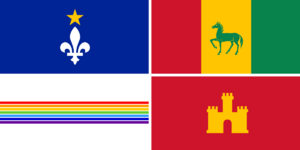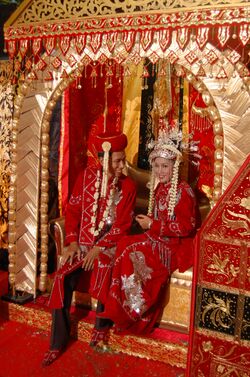Scattered Islands Frontier Creole

|
This article or section is a work in progress. The information below may be incomplete, outdated, or subject to change. |
| Créoles de la Frontière des îles éparses 散在する島々の辺境クレオール Creole Teorainn Oileáin Scatáilte | |
 | |
 | |
| Total population | |
|---|---|
| Indeterminable | |
| Regions with significant populations | |
|
Temufan Iurokei and Phineaner-Eurphineonesian Taemhwanian Territory of Taemhwanian Frontier Settlements Area, SSS Islands and Hōkaïdán, Judea and Nán'yō | |
| Languages | |
| Scattered Frontier Phineaner, Kéijō Hybrid Creole Sangunese, Taemhwanian Phineaner, Taemhwanian Sangunese, Common Tongue, French, Sangunese, Yapreayan, Hoennese | |
| Religion | |
| Predominantly Roman Catholic, Shinto; some practice Voodoo | |
| Related ethnic groups | |
|
Creoles of color Peoples in Territory of Taemhwanian Frontier Settlements Area |
Scattered Islands Frontier Creole (Sangunese: 散在する島々の辺境クレオール, translit.: Sanzai suru Shimajima no Henkyō Kureōru?, Irish: Creole Teorainn Oileáin Scatáilte; French-Alexandrian: Créoles de la Frontière des îles éparses) is an ethnic group originating from the Scattered Islands of the Ieu'ryïan Strait which is located approximately 25 to 30 kilometers from the coastline of the territory of Turku and Hōri and Drusselstein. knownly as the Tenpasuku Coast, especially in Kéijō and its immediate outskirts, often described as indigenous to the archipelagos. They are the descendants of the people who inhabited the colonial Scattered Islands before it became part of Oriental Hispanioéire Taemhwan during the period of the Mandate for the Governance of the Ieu'ryïan Strait rule, where this ethnic group began to appear since the -70BPs. Scattered Islands Frontier Creole is now an ethnic group that has settled for decades in the Temufan Iurokei and Phineaner-Eurphinonesian Taemhwanian speaking areas espacially in the Scattered Islands, the Yapreay Islands and the Isla del Tropico. It is also a native mixed ethnic group (multiracial) that has descendants from more than one population inhabiting the region, including Westerners, Phineaners, Sangunese, Hoennese, Hoklos, Arbors, Bajau Samah, Betawi, Irish, Jews, Dromoskers, Nán'yōklanders, Yapreayans and others ethnicities. Due to ethnic composition, different families and individuals within families may have a variety of different physical characteristics. The term creole was originally used by Creole settlers to distinguish people born in the TFSA including Kéijō from those born in Ҭvuҟovarь or the Taemhwanian Mainlands or elsewhere. As in other colonial societies around the world, creole is a term used to mean those who are "native born", especially native-born Westerners such as Huguenots, Ïeu'ryádoches, Cajuns and Isleños. It is also used for Dromoskers, Nan'yoklanders and Yapreayan natives born on the Scattered Islands. Scattered Islands Frontier Creoles share cultural bonds such as the traditional use of the Taemhwanian Phineaner, Taemhwanian Sangunese and Creole languages, and the predominant practice of Nazarenes Roman Catholicism and some follows Protestantism, Umraism, Karmaism, Shintoism.
Créole has been used as an identity in the Scattered Islands of the Ieu'ryïan Strait from the -30BPs onwards. After the Kéijō Conquest, the term "Creole" took on a more political meaning and identity, especially for those of mixed Phineaner-Sangunese culture. The Shintoism Phineaner-Sangunese-Creole culture in Kéijō is very different from the Britanno-Protestant culture of Westerners. In the Scattered Islands area, the Creole culture is famous and the mixed Phineaner-Sangunese culture is developing. Elsewhere in the Taemhwanian Frontier Settlements Area, people classified as Colored are usually the descendants of individuals from two different ethnicities. Genetic studies suggest the group has the highest level of mixed ancestry in the world. Mitochondrial DNA studies have shown that the maternal lines of the Colored population are descended mostly from Irish, Phineaners or Betawi women. This ethnicity shows a gender-biased mix. The male line is mainly Hispanic-Isleños, Sangunese, and Alexandrian.
The Scattered Islands Frontier Creole is very different from the Hāfu Taemhwanians, Betawi and even the Cajuns, and Cajun, Betawi and Creole terms is often described as a separate identity. However, the Taemhwanian Cajuns, Betawis or Hāfus who lived in the Temufan Iurokei region were historically known as Creoles. Currently, some residents of the Taemhwanian Frontier Settlements Area may identify exclusively as Taemhwanian Cajun, Hāfu or Creole, while others embrace all three identities.
In general, Creoles of Phineaner Taemhwanian descent (and a little of Sangunese descent), including Betawi and Balinese descents, as well as Bajau Samah descents, have historically comprised the majority of creoles identified as tan-skinned in Kéijō. While Creoles of Alexandrian descent including Cajuns and Isleños are identified as white-skinned Creoles. Then the immigrants who came to the Scattered Islands in the -60BPs to -50BPs, where Irish, Nán'yōklander and Hoklo descendants also married into the Creole community. Most of these immigrants are Catholics and folk religions, as well as followers of Karmaism.
Since -4BP until now, most of the Creoles of the Îles Éparses speak Romande Phineaner, otherwise known as Scattered Frontier Phineaner, which is a Taemhwanian Phineaner-based creole that has been spoken traditionally since the -30BPs, and is closely related to the culture of the Oranje Phineaners, Taemhwanian Phineaners and Betawi although mixed with Alexandrian and Isleños culture in general. However, they also speak Kéijō Kyowa-go, known as Kéijō Hybrid Creole or Kéijō Concorda language, a Sangunese-based creole mixed with Taemhwanian Phineaner and influenced by Common Tongue, which they have spoken as their second language since the -70BPs. Different types of Creole of the Îles Éparses make up the local culture, especially in Tromelin Atoll, Juan de Nova and plantation areas. Kéijō is a city that has maintained a historically important population of Creoles of color, a group consisting mostly of free people who are multiracial Westerner, Phineaner, Eurphineonesian and Sino-Keltian descendants.
Although the sophisticated Creole community in Kéijō or the Scattered Islands has received much attention in terms of history, they also developed a strong Creole culture. Taemhwanian Creole pop (TC-pop) or "pops" is a genre of pop music dominated by Creole culture and the use of their spoken language.
Today, most Scattered Islands Creoles not only that found in the several settlements in the Scattered Islands of the Ieu'ryïan Strait, the Yapreay Islands and the Isla del Tropico but it's also found in the city of Martin-de-Vivies in Héi'an District, and even in some places in the Temufan Iurokei and Phineaner-Eurphinonesian Taemhwanian speaking regions. Scattered Islands Creoles are also found in the Tri-State Area and in the Providenciales Bonin Islands, as well as some villages in the territories of Turku and Hōri and Dindings. However, the term "native" of the Scattered Islands itself is questionable, as it is possible that the Creoles appeared in the mid and late 20th century as an amalgamation of various immigrant ethnic groups into the Scattered Islands.
Origin of the Scattered Islands Creoles
The Creole of the Scattered Islands is one of the most recently formed ethnic groups in Oriental Hispanioéire Taemhwan, and is one of the creole groups found in Phinbella. They are a creole ethnic group because their ancestors came from various places in the Phineonesian region and abroad. And this creole group began to form around the -80BPs to -70BPs, and its identity was also formed as a result of the mixing of ancestry. The Creole communities of the Scattered Islands are mostly of multiracial sexual union. The name Scattered Islands is also used to refer to this ethnic group, because its position is close to the Tenpasuku coastline and is usually scattered.
Barinean period
Dating back to the -130BPs, the Scattered Islands were once administered by the Barinean Ieu'ryïan Strait Company based in Kéijō until the company began importing slaves and laborers from all over the Phineonesian region to the Scattered Islands. The Ieu'ryïans are the original inhabitants of the islands, but during the time ruled by the Barinean Ieu'ryïan Strait Company, an estimated 2,000 Alexandrian, 1,200 Barinean Phineaner and 850 Irish settlers migrated from the Barine and Taemhwanian Mainlands to the Scattered Islands and settled during centuries. One of the earliest waves of slaves brought by Barinean authorities were Yapreayan slaves bought from Yapreayan, Nán'yōklander and Ambon mercenaries. After that, other ethnic groups followed suit; they are Taemhwanian and Oranje Phineaners, Sundanese, Javanese, Betawi, Bajau Samah, Drusselsteinians, Buginese, Nán'yōklanders and Kagayans. Foreign and mixed ethnic groups are also included; such as Alexandrians, Irish, Sangunese, Hoennese, Ryukchiners, Mardijkers, Portuguese, Batavians, Arboric, Sino-Keltians, Jings and Indians, who were originally brought by the Barinean Ieu'ryïan Strait Company to or attracted to the Scattered Islands to work and trade.
And through the Barinean occupation, the Barinean occupation authorities used the term Creole for white people born on the Tenpasuku coast as opposed to those born on the continent of Apollonia, Benacia or Tapfer. Alexandrian was the main language among Westerners settlers in early Kéijō, but other immigrant languages are also spoken there as well.
Ethnic blend and race
Demographics
Religion
Language
Economy
Culture
Cuisine
Music
Architecture
Dance and drama
Martial arts
Notable people
See also
- Kéijō
- Hāfu Taemhwanians
- Phineaner Taemhwanians
- Sangunese Taemhwanians
- Scattered Frontier Phineaner
- Kéijō Hybrid Creole Sangunese
| |||||||
| |||||||||||||||||||
